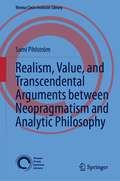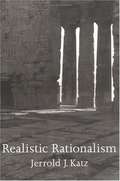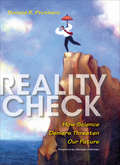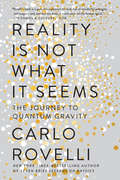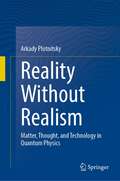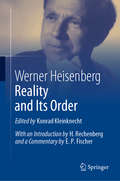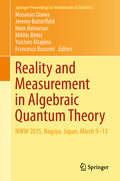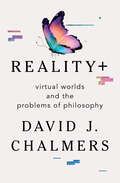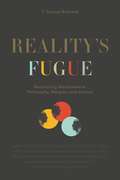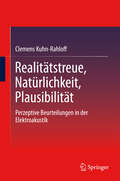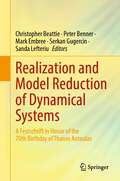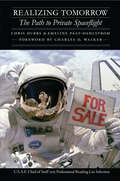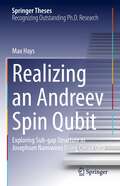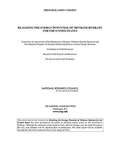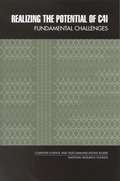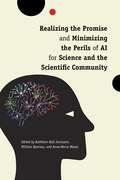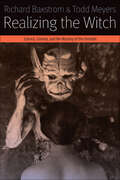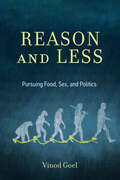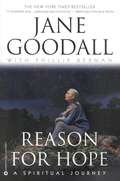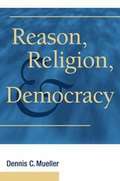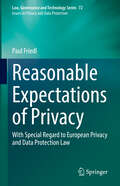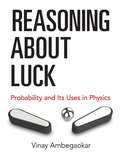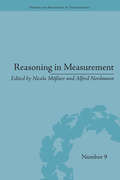- Table View
- List View
Realism, Value, and Transcendental Arguments between Neopragmatism and Analytic Philosophy (Vienna Circle Institute Library #7)
by Sami PihlströmThe essays collected in this volume and authored by Sami Pihlström emphasize that our relation to the world we live in and seek to represent and get to know better through our practices of conceptualization and inquiry is irreducibly valuational. There is no way of even approaching, let alone resolving, the philosophical issue of realism without drawing due attention to the ways in which human values are inextricably entangled with even the most purely “factual” projects of inquiry we engage in.This entanglement of the factual and the normative is, as explicitly argued in Chapter 7 but implicitly suggested in all the other chapters as well, both pragmatic (practice-embedded and practice-involving) and transcendental (operating at the level of the necessary conditions for the possibility of our representing and cognizing the world in general). The author claims we need to carefully examine the complex relations of realism, value, and transcendental arguments at the intersection of pragmatism and analytic philosophy. This book does so by offering case-studies of various important neopragmatists and philosophers close to the pragmatist tradition, including Hilary Putnam, Nicholas Rescher, Joseph Margolis, and Ludwig Wittgenstein. It appeals to scholars and advanced graduate students focusing on pragmatism and analytic philosophy.
Realistic Rationalism
by Jerrold J. KatzJerrold J. Katz develops a new philosophical position integrating realism and rationalism. Realism here means that the objects of study in mathematics and other formal sciences are abstract; rationalism means that our knowledge of them is not empirical.
Reality Check: How Science Deniers Threaten Our Future
by Donald R. ProtheroA thought-provoking look at science denialism &“for popular science readers who want better to be able to explain and defend science and scientific methods to others&” (Library Journal). The battles over evolution, climate change, childhood vaccinations, and the causes of AIDS, alternative medicine, oil shortages, population growth, and the place of science in our country—all are reaching a fevered pitch. Many people and institutions have exerted enormous efforts to misrepresent or flatly deny demonstrable scientific reality to protect their nonscientific ideology, their power, or their bottom line. To shed light on this darkness, Donald R. Prothero explains the scientific process and why society has come to rely on science not only to provide a better life but also to reach verifiable truths no other method can obtain. He describes how major scientific ideas that are accepted by the entire scientific community (evolution, anthropogenic global warming, vaccination, the HIV cause of AIDS, and others) have been attacked with totally unscientific arguments and methods. Prothero argues that science deniers pose a serious threat to society, as their attempts to subvert the truth have resulted in widespread scientific ignorance, increased risk of global catastrophes, and deaths due to the spread of diseases that could have been prevented. &“Prothero&’s treatise will give the science-minded something to cheer about, a brief summary of the real data that supports so many critical aspects of modern life.&” —Publishers Weekly
Reality Is Not What It Seems: The Journey to Quantum Gravity
by Carlo Rovelli Erica Segre Simon Carnell<P><P>From the New York Times–bestselling author of Seven Brief Lessons on Physics, a closer look at the mind-bending nature of the universe.What are the elementary ingredients of the world? Do time and space exist? And what exactly is reality? <P><P>Theoretical physicist Carlo Rovelli has spent his life exploring these questions. He tells us how our understanding of reality has changed over the centuries and how physicists think about the structure of the universe today. <P><P>In elegant and accessible prose, Rovelli takes us on a wondrous journey from Democritus to Albert Einstein, from Michael Faraday to gravitational waves, and from classical physics to his own work in quantum gravity. <P><P>As he shows us how the idea of reality has evolved over time, Rovelli offers deeper explanations of the theories he introduced so concisely in Seven Brief Lessons on Physics. <P><P>This book culminates in a lucid overview of quantum gravity, the field of research that explores the quantum nature of space and time, seeking to unify quantum mechanics and general relativity. <P><P>Rovelli invites us to imagine a marvelous world where space breaks up into tiny grains, time disappears at the smallest scales, and black holes are waiting to explode—a vast universe still largely undiscovered.
Reality Without Realism: Matter, Thought, and Technology in Quantum Physics
by Arkady PlotnitskyThis book presents quantum theory as a theory based on new relationships among matter, thought, and experimental technology, as against those previously found in physics, relationships that also redefine those between mathematics and physics in quantum theory. The argument of the book is based on its title concept, reality without realism (RWR), and in the corresponding view, the RWR view, of quantum theory. The book considers, from this perspective, the thinking of Bohr, Heisenberg, Schrödinger, and Dirac, with the aim of bringing together the philosophy and history of quantum theory. With quantum theory, the book argues, the architecture of thought in theoretical physics was radically changed by the irreducible role of experimental technology in the constitution of physical phenomena, accordingly, no longer defined independently by matter alone, as they were in classical physics or relativity. Or so it appeared. For, quantum theory, the book further argues, made us realize that experimental technology, beginning with that of our bodies, irreducibly shapes all physical phenomena, and thus makes us rethink the relationships among matter, thought, and technology in all of physics.
Reality and Its Order
by Werner HeisenbergAvailable here for the first time in English, "Reality and Its Order" is a remarkable philosophical text by Werner Heisenberg, the father of quantum mechanics and one of the leading scientists of the 20th century. Written during the wartime years and initially distributed only to his family and trusted friends, the essay describes Heisenberg’s philosophical view of how we understand the natural world and our role within it. In this volume, the essay is introduced by the physicist Helmut Rechenberg and annotated by the science historian Ernst Peter Fischer. The content, particularly within its historical context, will be of great interest to many physicists, philosophers and historians of science.
Reality and Measurement in Algebraic Quantum Theory: Nagoya, Japan, March 9-13 2015 (Springer Proceedings in Mathematics & Statistics #261)
by Miklós Rédei Francesco Buscemi Jeremy Butterfield Masanao Ozawa Hans Halvorson Yuichiro KitajimaThis volume contains papers based on presentations at the “Nagoya Winter Workshop 2015: Reality and Measurement in Algebraic Quantum Theory (NWW 2015)”, held in Nagoya, Japan, in March 2015. The foundations of quantum theory have been a source of mysteries, puzzles, and confusions, and have encouraged innovations in mathematical languages to describe, analyze, and delineate this wonderland. Both ontological and epistemological questions about quantum reality and measurement have been placed in the center of the mysteries explored originally by Bohr, Heisenberg, Einstein, and Schrödinger. This volume describes how those traditional problems are nowadays explored from the most advanced perspectives. It includes new research results in quantum information theory, quantum measurement theory, information thermodynamics, operator algebraic and category theoretical foundations of quantum theory, and the interplay between experimental and theoretical investigations on the uncertainty principle. This book is suitable for a broad audience of mathematicians, theoretical and experimental physicists, and philosophers of science.
Reality+: Virtual Worlds and the Problems of Philosophy
by David J. ChalmersA leading philosopher takes a mind-bending journey through virtual worlds, illuminating the nature of reality and our place within it. Virtual reality is genuine reality; that’s the central thesis of Reality+. In a highly original work of “technophilosophy,” David J. Chalmers gives a compelling analysis of our technological future. He argues that virtual worlds are not second-class worlds, and that we can live a meaningful life in virtual reality. We may even be in a virtual world already. Along the way, Chalmers conducts a grand tour of big ideas in philosophy and science. He uses virtual reality technology to offer a new perspective on long-established philosophical questions. How do we know that there’s an external world? Is there a god? What is the nature of reality? What’s the relation between mind and body? How can we lead a good life? All of these questions are illuminated or transformed by Chalmers’ mind-bending analysis. Studded with illustrations that bring philosophical issues to life, Reality+ is a major statement that will shape discussion of philosophy, science, and technology for years to come.
Reality’s Fugue: Reconciling Worldviews in Philosophy, Religion, and Science
by F. Samuel BrainardScience, religion, philosophy: these three categories of thought have organized humankind’s search for meaning from time immemorial. Reality’s Fugue presents a compelling case that these ways of understanding, often seen as competing, are part of a larger puzzle that cannot be rendered by one account of reality alone.This book begins with an overview of the concept of reality and the philosophical difficulties associated with attempts to account for it through any single worldview. By clarifying the differences among first-person, third-person, and dualist understandings of reality, F. Samuel Brainard repurposes the three predominant ways of making sense of those differences: exclusionist (only one worldview can be right), inclusivist (viewing other worldviews through the lens of one in order to incorporate them all, and thus distorting them), and pluralist or relativist (holding that there are no universals, and truth is relative). His alternative mode of understanding uses Douglas Hofstadter’s metaphor of a musical fugue that allows different “voices” and “melodies” of worldviews to coexist in counterpoint and conversation, while each remains distinct, with none privileged above the others. Approaching reality in this way, Brainard argues, opens up the possibility for a multivoiced perspective that can overcome the skeptical challenges that metaphysical positions face.Engagingly argued by a lifelong scholar of philosophy and global religions, this edifying and accessible exploration of the nature of reality addresses deeply meaningful questions about belief, reconciliation, and being.
Reality’s Fugue: Reconciling Worldviews in Philosophy, Religion, and Science
by F. Samuel BrainardScience, religion, philosophy: these three categories of thought have organized humankind’s search for meaning from time immemorial. Reality’s Fugue presents a compelling case that these ways of understanding, often seen as competing, are part of a larger puzzle that cannot be rendered by one account of reality alone.This book begins with an overview of the concept of reality and the philosophical difficulties associated with attempts to account for it through any single worldview. By clarifying the differences among first-person, third-person, and dualist understandings of reality, F. Samuel Brainard repurposes the three predominant ways of making sense of those differences: exclusionist (only one worldview can be right), inclusivist (viewing other worldviews through the lens of one in order to incorporate them all, and thus distorting them), and pluralist or relativist (holding that there are no universals, and truth is relative). His alternative mode of understanding uses Douglas Hofstadter’s metaphor of a musical fugue that allows different “voices” and “melodies” of worldviews to coexist in counterpoint and conversation, while each remains distinct, with none privileged above the others. Approaching reality in this way, Brainard argues, opens up the possibility for a multivoiced perspective that can overcome the skeptical challenges that metaphysical positions face.Engagingly argued by a lifelong scholar of philosophy and global religions, this edifying and accessible exploration of the nature of reality addresses deeply meaningful questions about belief, reconciliation, and being.
Realitätstreue, Natürlichkeit, Plausibilität
by Clemens Kuhn-RahloffDieses Buch richtet sich an Ingenieure und Forscher im Bereich der Kommunikationsakustik und anderen Gebieten der Wahrnehmungsforschung. Es bewegt sich im interdisziplinären Feld von Kommunikationsakustik, Informationstheorie und Wahrnehmungspsychologie und liefert einen wesentlichen Beitrag zum Verständnis der akustischen Wahrnehmung. Im Zentrum steht dabei der Begriff der Plausibilität als grundlegender Bestandteil kommunikationsakustischer Technik. Um Eigenschaften von Plausibilitätsurteilen bei der akustischen Wahrnehmung zu von Menschen zu erörtern, stellt das Buch ausgewählte top-down-Prozesse der Wahrnehmung in den Vordergrund, die das Urteilsverhalten beeinflussen. Plausibilität wird im Kontext existierender Modelle für perzeptive Messungen dargestellt und die Anforderungen werden diskutiert, die an den Begriff gestellt werden, wenn er im psychoakustischen Sinn als Messgröße aufgefasst wird.
Realization and Model Reduction of Dynamical Systems: A Festschrift in Honor of the 70th Birthday of Thanos Antoulas
by Peter Benner Mark Embree Christopher Beattie Serkan Gugercin Sanda LefteriuThis book celebrates Professor Thanos Antoulas's 70th birthday, marking his fundamental contributions to systems and control theory, especially model reduction and, more recently, data-driven modeling and system identification. Model reduction is a prominent research topic with wide ranging scientific and engineering applications.
Realizing Tomorrow: The Path to Private Spaceflight (Outward Odyssey: A People's History of Spaceflight)
by Chris Dubbs Emeline Paat-DahlstromU.S.A.F. Chief of Staff 2013 Professional Reading List Selection Nearly forty years passed between the Apollo moon landings, the grandest accomplishment of a government-run space program, and the Ansari X PRIZE–winning flights of SpaceShipOne, the greatest achievement of a private space program. Now, as we hover on the threshold of commercial spaceflight, authors Chris Dubbs and Emeline Paat-Dahlstrom look back at how we got to this point.Their book traces the lives of the individuals who shared the dream that private individuals and private enterprise belong in space. Realizing Tomorrow provides a behind-the-scenes look at the visionaries, the crackpots, the financial schemes, the legal wrangling, the turf battles, and—underpinning the entire drama—the overwhelming desire of ordinary people to visit outer space. A compelling story of the pioneers of commercial spaceflight—and their efforts to open the final frontier to everyone—this book traces the path to private spaceflight even as it offers an instructive, entertaining, and cautionary note about its future.
Realizing an Andreev Spin Qubit: Exploring Sub-gap Structure in Josephson Nanowires Using Circuit QED (Springer Theses)
by Max HaysThe thesis gives the first experimental demonstration of a new quantum bit (“qubit”) that fuses two promising physical implementations for the storage and manipulation of quantum information – the electromagnetic modes of superconducting circuits, and the spins of electrons trapped in semiconductor quantum dots – and has the potential to inherit beneficial aspects of both. This new qubit consists of the spin of an individual superconducting quasiparticle trapped in a Josephson junction made from a semiconductor nanowire. Due to spin-orbit coupling in the nanowire, the supercurrent flowing through the nanowire depends on the quasiparticle spin state. This thesis shows how to harness this spin-dependent supercurrent to achieve both spin detection and coherent spin manipulation. This thesis also represents a significant advancement to our understanding and control of Andreev levels and thus of superconductivity. Andreev levels, microscopic fermionic modes that exist in all Josephson junctions, are the microscopic origin of the famous Josephson effect, and are also the parent states of Majorana modes in the nanowire junctions investigated in this thesis. The results in this thesis are therefore crucial for the development of Majorana-based topological information processing.
Realizing the Energy Potential of Methane Hydrate for the United States
by National Research Council of the National AcademiesNatural gas, composed mostly of methane, is the cleanest of all the fossil fuels, emitting 25-50% less carbon dioxide than either oil or coal for each unit of energy produced. In recent years, natural gas supplied approximately 20-25% of all energy consumed in the United States. Methane hydrate is a potentially enormous and as yet untapped source of methane. The Department of Energy's Methane Hydrate Research and Development Program has been tasked since 2000 to implement and coordinate a national methane hydrate research effort to stimulate the development of knowledge and technology necessary for commercial production of methane from methane hydrate in a safe and environmentally responsible way. Realizing the Energy Potential of Methane Hydrate for the United States evaluates the program's research projects and management processes since its congressional re-authorization in 2005, and presents recommendations for its future research and development initiatives.
Realizing the Potential of C4I: Fundamental Challenges
by Committee to Review DOD C4I Plans ProgramsRapid progress in information and communications technologies is dramatically enhancing the strategic role of information, positioning effective exploitation of these technology advances as a critical success factor in military affairs. These technology advances are drivers and enablers for the "nervous system" of the military—its command, control, communications, computers, and intelligence (C4I) systems—to more effectively use the "muscle" side of the military.Authored by a committee of experts drawn equally from the military and commercial sectors, Realizing the Potential of C4I identifies three major areas as fundamental challenges to the full Department of Defense (DOD) exploitation of C4I technology—information systems security, interoperability, and various aspects of DOD process and culture. The book details principles by which to assess DOD efforts in these areas over the long term and provides specific, more immediately actionable recommendations. Although DOD is the focus of this book, the principles and issues presented are also relevant to interoperability, architecture, and security challenges faced by government as a whole and by large, complex public and private enterprises across the economy.
Realizing the Promise and Minimizing the Perils of AI for Science and the Scientific Community
by Kathleen Hall Jamieson, William Kearney, and Anne-Marie MazzaRecommendations from the scientific community to ensure that the development and use of AI honors scientific normsIn late 2022, OpenAI released ChatGPT, an AI chatbot capable of generating conversational answers and analyses, as well as images, in response to user questions and prompts. This generative AI is built with computational procedures, such as large language models, that train on vast bodies of human-created and curated data, including huge amounts of scientific literature. Since then, the worry that AI may someday outsmart humans has only grown more widespread.In the past, as society grappled with the implications of new technologies—ranging from nuclear energy to recombinant DNA—the scientific community developed practices designed to increase adherence to the norms that have protected the integrity of each new form of scientific exploration, development, and deployment. In the process, scientists expanded their community’s repertoire of mechanisms designed to advance emerging science and technology while safeguarding the integrity of science and the wellbeing of the nation and its people.This book provides a historical perspective on and an ethical approach to emerging AI technologies; an overview of AI frameworks and principles; and an assessment of AI’s current advances, hurdles, and potential. Experts from the fields of behavioral and social sciences, ethics, biology, physics, chemistry, mathematics, and computer science, as well as leaders in higher education, law, governance, and science publishing and communication, comprise the book’s contributors. Their essays remind us that, even as our understandings of emerging technologies and of their implications evolve, science’s commitment to core norms and values remains steadfast. The volume’s conclusion advocates for following principles of human accountability and responsibility when using artificial intelligence in research, including transparent disclosure and attribution; verification and documentation of AI-generated data and analysis; a focus on ethics and equity; and continuous oversight and public engagement.
Realizing the Witch: Science, Cinema, and the Mastery of the Invisible (Forms of Living)
by Richard Baxstrom Todd MeyersBenjamin Christensen’s Häxan (The Witch, 1922) stands as a singular film within the history of cinema. Deftly weaving contemporary scientific analysis and powerfully staged historical scenes of satanic initiation, confession under torture, possession, and persecution, Häxan creatively blends spectacle and argument to provoke a humanist re-evaluation of witchcraft in European history as well as the contemporary treatment of female “hysterics” and the mentally ill.In Realizing the Witch, Baxstrom and Meyers show how Häxan opens a window onto wider debates in the 1920s regarding the relationship of film to scientific evidence, the evolving study of religion from historical and anthropological perspectives, and the complex relations between popular culture, artistic expression, and concepts in medicine and psychology. Häxan is a film that travels along the winding path of art and science rather than between the narrow division of “documentary” and “fiction.” Baxstrom and Meyers reveal how Christensen’s attempt to tame the irrationality of “the witch” risked validating the very "nonsense" that such an effort sought to master and dispel. Häxan is a notorious, genre-bending, excessive cinematic account of the witch in early modern Europe. Realizing the Witch not only illustrates the underrated importance of the film within the canons of classic cinema, it lays bare the relation of the invisible to that which we cannot prove but nevertheless “know” to be there.
Rearming Israel: Defense Procurement Through The 1990s (Publications Of The Jaffee Center For Strategic Studies, Tel Aviv University #No. 17)
by Aharon Klieman Reuven PedatzurThis study analyzes the key functions of arms planning and procurement in the ongoing Israeli defence effort. Part I addresses individual constraints placed on the shaping of arms control policy. Part II asks how Israel might best meet its arms needs over the next decade.
Reason and Less: Pursuing Food, Sex, and Politics
by Vinod GoelA new, biologically driven model of human behavior in which reason is tethered to the evolutionarily older autonomic, instinctive, and associative systems. In Reason and Less, Vinod Goel explains the workings of the tethered mind. Reason does not float on top of our biology but is tethered to evolutionarily older autonomic, instinctive, and associative systems. After describing the conceptual and neuroanatomical basis of each system, Goel shows how they interact to generate a blended response. Goel&’s commonsense account drives human behavior back into the biology, where it belongs, and provides a richer set of tools for understanding how we pursue food, sex, and politics. Goel takes the reader on a journey through psychology (cognitive, behavioral, developmental, and evolutionary), neuroscience, philosophy, ethology, economics, and political science to explain the workings of the tethered mind. One key insight that holds everything together is that feelings—generated in old, widely conserved brain stem structures—are evolution&’s solution to initiating and selecting all behaviors, and provide the common currency for the different systems to interact. Reason is as much about feelings as are lust and the taste of chocolate cake. All systems contribute to behavior and the overall control structure is one that maximizes pleasure and minimizes displeasure. Tethered rationality has some sobering and challenging implications for such real-world human behaviors as climate change denial, Trumpism, racism, or sexism. They cannot be changed simply by targeting beliefs but will require more drastic measures, the nature of which depends on the specific behavior in question. Having an accurate model of human behavior is the crucial first step.
Reason for Hope: A Spiritual Journey (Windsor Selection Ser.)
by Jane Goodall Phillip BermanAs a young woman, Jane Goodall was best known for her groundbreaking fieldwork with the chimpanzees of Gombe, Africa. Goodall's work has always been controversial, mostly because she broke the mold of research scientist by developing meaningful relationships with her "specimens" and honoring their lives as she would other humans. Now at the age of 60, she continues to break the mold of scientist by revealing how her research and worldwide conservation institutes spring from her childhood callings and adult spiritual convictions. Reason for Hope is a smoothly written memoir that does not shy away from facing the realities of environmental destruction, animal abuse, and genocide. But Goodall shares her antidote to the poison of despair with specific examples of why she has not lost faith. For instance, she shares her spiritual epiphany during a visit to Auschwitz; her bravery in the face of chimpanzee imprisonment in medical laboratories; and devotes a whole chapter to individuals, corporations, and countries that are doing the right thing. But most of all Goodall provides a beautifully written plea for why everyone can and must find a reason for hope. --Gail Hudson
Reason, Religion, and Democracy
by Dennis C. MuellerThe rise of religious fundamentalism in different parts of the world in recent years and its association with terrorism has led to renewed interest in the nature of religion and its compatibility with Western institutions. Much of the focus of this new interest has contrasted religion and science as systems of knowledge. This book also emphasizes the difference between religion and science as means for understanding causal relationships, but it focuses much more heavily on the challenge religious extremism poses for liberal democratic institutions. The treatment contains a discussion of human psychology, describes the salient characteristics of all religions, and contrasts religion and science as systems of thought. Historical sketches are used to establish a link between modernity and the use of the human capacity for reasoning to advance human welfare. The book describes the conditions under which democratic institutions can advance human welfare, and the nature of constitutional rights as protectors of individual freedoms. Extremist religions are shown to pose a threat to liberal democracy, a threat that has implications for immigration and education policies and the definition of citizenship.
Reasonable Expectations of Privacy: With Special Regard to European Privacy and Data Protection Law (Law, Governance and Technology Series #72)
by Paul Friedl‘Reasonable expectations of privacy’ have become a cornerstone concept in privacy and data protection legislation worldwide, extending today from US constitutional law to the GDPR, Article 8 ECHR, and various Asian and African data protection frameworks. This book offers a comprehensive analysis of this complex and ambiguous legal concept, addressing the many questions regarding its proper function, interpretation and application. Tracing the notion's evolution from the 1967 Supreme Court ruling in ‘Katz v United States’ to its status as a widespread paradigm of global privacy discourse, the work illuminates the many fallacies that pervade both academic and judicial interpretations. At its core, the book explores and evaluates four distinct models of ‘reasonable expectations,’ analysing their normative foundations and practical implications in depth. In doing so, the book also contributes to broader discussions within privacy and data protection theory, as it identifies and evaluates different strategies for regulating privacy conflicts, such as interest balancing or social norms-based regulation. Finally, the book also makes significant contributions to the scholarship on the EU General Data Protection Regulation (GDPR) and Article 8 ECHR, evaluating how 'reasonable expectations' operate within these contexts from empiric and normative perspectives.
Reasoning About Luck: Probability and Its Uses in Physics (Dover Books on Physics)
by Vinay AmbegaokarThis book introduces college students and other readers to the uses of probability and statistics in the physical sciences, focusing on thermal and statistical physics and touching upon quantum physics. Widely praised as beautifully written and thoughtful, Reasoning About Luck explains concepts in a way that readers can understand and enjoy, even students who are not specializing in science and those outside the classroom — only some familiarity with basic algebra is necessary. Attentive readers will come away with a solid grasp of many of the basic concepts of physics and some excellent insights into the way physicists think and work. "If students who are not majoring in science understood no more physics than that presented by Ambegaokar, they would have a solid basis for thinking about physics and the other sciences." — Physics Today."There is a real need for rethinking how we teach thermal physics—at all levels, but especially to undergraduates. Professor Ambegaokar has done just that, and given us an outstanding and ambitious textbook for nonscience majors. I find Professor Ambegaokar's style throughout the book to be graceful and witty, with a nice balance of both encouragement and admonishment." — American Journal of Physics.
Reasoning in Measurement (History and Philosophy of Technoscience)
by Nicola Mößner and Alfred NordmannThis collection offers a new understanding of the epistemology of measurement. The interdisciplinary volume explores how measurements are produced, for example, in astronomy and seismology, in studies of human sexuality and ecology, in brain imaging and intelligence testing. It considers photography as a measurement technology and Henry David Thoreau's poetic measures as closing the gap between mind and world. By focusing on measurements as the hard-won results of conceptual as well as technical operations, the authors of the book no longer presuppose that measurement is always and exclusively a means of representing some feature of a target object or entity. Measurement also provides knowledge about the degree to which things have been standardized or harmonized – it is an indicator of how closely human practices are attuned to each other and the world.
